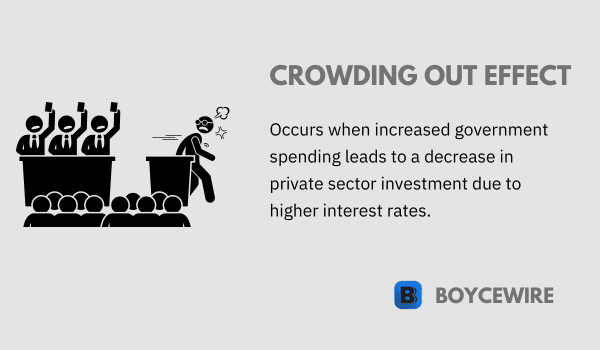Crowding Out Effect: Definition, Causes, Effects & Examples

What is the Crowding Out Effect?
The crowding out effect is a pivotal concept in economic theory, particularly in discussions surrounding government spending and its impact on private sector investments. Essentially, the crowding out effect suggests that increased public sector spending, especially financed by borrowing, can lead to a decrease in spending by the private sector.
This theory is rooted in the fundamental economic idea of limited resources: when the government borrows to finance increased spending, it absorbs a larger portion of the economy’s savings, leaving less available for private investors. This can result in higher interest rates and reduced private investment, which is essentially the crowding out effect.
Key Points
- The crowding out effect refers to the phenomenon where increased government borrowing and spending leads to a reduction in private sector investment.
- It occurs when government demand for funds in the financial market increases, causing interest rates to rise.
- Higher interest rates discourage private sector borrowing and investment, resulting in a decrease in private investment and economic growth.
Understanding the Crowding Out Effect
The crowding out effect is an economic theory that posits an increase in public sector spending, often through increased government borrowing, can lead to a decrease in certain types of private sector spending. This effect is primarily considered in the context of fiscal policy and government budget deficits.
The mechanics work like this:
- Increased Government Borrowing Suppose the government decides to increase its spending to stimulate the economy, finance a public project, or increase social benefits. If the government doesn’t have enough revenue to cover this increased spending, it may choose to borrow the funds, often by issuing government bonds.
- Higher Demand for Loanable Funds The increased government borrowing raises the demand for loanable funds in the economy. In economic terms, “loanable funds” refer to all income that individuals (or institutions) choose to save and lend out, rather than use for personal consumption.
- Rising Interest Rates With the government absorbing a larger share of the economy’s available savings, fewer funds are available for private sector borrowing. This scarcity can cause interest rates to rise, due to the laws of supply and demand.
- Reduced Private Investment As interest rates rise, borrowing becomes more expensive for businesses and individuals. This can discourage private investment, as the cost of financing new projects or purchases increases. Consequently, private sector spending might decrease.
In essence, the crowding out effect suggests that increased government borrowing and spending can “crowd out” or displace private sector investment by driving up interest rates.
It’s important to note, however, that the extent of the crowding out effect can depend on various factors, including the state of the economy. In some situations, government spending might also lead to a ‘crowding in’ effect, stimulating rather than displacing private investment.
Types of Crowding Out Effect
The crowding out effect is an economic theory that posits an increase in public sector spending, often through increased government borrowing, can lead to a decrease in certain types of private sector spending. This effect is primarily considered in the context of fiscal policy and government budget deficits.
- Fiscal (or Financial) Crowding Out This is the most commonly discussed form of crowding out. It occurs when government borrowing increases interest rates, which in turn discourages private investment. As we’ve discussed earlier, when the government borrows to finance its spending, it absorbs a larger portion of the economy’s available savings. This increased demand for loanable funds can lead to higher interest rates, making it more expensive for businesses to finance new investments. As a result, private investment decreases.
- Real Crowding Out Real crowding out happens when government spending uses resources that would otherwise be used by the private sector, irrespective of changes in interest rates. This type of crowding out can occur when an economy is operating at or near full capacity. In such cases, an increase in government spending can absorb labor, capital, or other resources that would have been used by the private sector. The displacement of private sector activity in this case is not due to higher interest rates but because of the direct competition for resources.
It’s crucial to remember that the degree to which these crowding out effects occur depends on various factors, including the overall state of the economy, the initial level of government debt, and the effectiveness of the country’s monetary policy. Therefore, the effect is not a foregone conclusion whenever government spending increases; instead, it’s a potential consequence that depends on specific economic circumstances.
Causes of the Crowding Out Effect
The crowding out effect, at its core, is driven by changes in government spending and borrowing. However, there are several factors that can contribute to or influence the extent of the crowding out effect. Here are some key causes:
1. Increased Government Spending
A significant increase in government spending, particularly when financed by borrowing, can lead to the crowding out effect. The increased demand for loanable funds can drive up interest rates, making borrowing more expensive for private entities.
2. Government Deficit Financing
If a government consistently spends more than it earns in revenue, it must finance this deficit by borrowing. Persistent government deficit financing can exert upward pressure on interest rates over time, potentially crowding out private investment.
3. Monetary Policy
The stance of monetary policy can influence the extent of the crowding out effect. If a country’s central bank accommodates the increased government spending by expanding the money supply, it can prevent interest rates from rising, thereby mitigating the crowding out effect. However, if the central bank does not adjust the money supply, the crowding out effect may be more pronounced.
4. Economic Conditions
The state of the economy can also impact the severity of the crowding out effect. In a booming economy operating at full capacity, increased government spending can lead to a real crowding out effect as the government and private sector compete for limited resources. In contrast, during a recession, when there is unused capacity in the economy, the crowding out effect may be less significant.
5. Financial Markets
The level of financial development and the openness of financial markets can also play a role. In countries with well-developed financial markets, increased government borrowing might not significantly impact interest rates, thereby reducing the extent of fiscal crowding out. Conversely, in countries with less developed financial markets, the impact could be more pronounced.
Effects of the Crowding Out Effect
The crowding out effect can have significant implications for an economy, impacting various aspects such as private investment, interest rates, and economic growth. Here are some key effects:
Reduced Private Investment
A primary consequence of the crowding out effect is a decrease in private sector investment. As the government borrows more, interest rates can rise, making borrowing more expensive for businesses and households. This can discourage private investment and potentially slow economic growth.
Higher Interest Rates
An increased demand for loanable funds by the government can lead to higher interest rates. These higher rates can affect not just business investment but also consumer spending, particularly on interest-sensitive purchases like homes and cars.
Slower Economic Growth
In the long run, reduced private investment can result in slower economic growth. This is because investment is a key driver of economic growth, contributing to the accumulation of capital and often enhancing productivity through technological progress.
Changes in Aggregate Demand
The crowding out effect can also impact aggregate demand. Initially, increased government spending can boost aggregate demand. However, if the rise in interest rates significantly reduces investment and consumer spending, it could potentially offset the initial increase in aggregate demand.
Inflationary Pressure
If the economy is operating near full capacity, increased government spending can create inflationary pressure. If demand for goods and services exceeds supply, prices generally rise. This effect might be exacerbated if the central bank expands the money supply to accommodate government borrowing.
Increased Government Debt
If the crowding out effect leads to slower economic growth, this could reduce government revenue from taxes. Over time, this could result in higher levels of government debt and could potentially lead to a vicious cycle of borrowing and crowding out.
Examples of the Crowding Out Effect
While the crowding out effect is a theoretical concept, it has been identified in various real-world scenarios. Here are a couple of examples to illustrate how the crowding out effect can manifest:
- Post-World War II United States After World War II, the U.S. government ran large budget deficits to finance the war effort. As government borrowing increased, the demand for loanable funds rose, which drove up interest rates. As a result, there was less private investment, providing a real-world example of the crowding out effect.
- Debt Crisis in Greece During the 2010s, Greece experienced a severe debt crisis, partly due to excessive government borrowing. The increased borrowing led to higher interest rates, which made it more expensive for businesses in Greece to borrow and invest. As a result, private investment fell, which is an example of fiscal crowding out.
- Developing Economies with Limited Resources In developing countries where resources are limited, increased government spending on public projects can lead to real crowding out. For instance, if a government employs a large proportion of the available labor force for a public works project, fewer workers may be available for private sector employment, thus potentially limiting private sector output.
These examples serve to illustrate the potential impacts. However, it’s important to note that the extent and significance of the crowding out effect can depend greatly on the specific economic context and policy environment.
FAQs
The crowding out effect refers to the reduction in private sector investment that occurs when increased government borrowing and spending lead to higher interest rates.
When the government increases its demand for funds in the financial market, it causes interest rates to rise, which discourages private sector borrowing and investment.
The crowding out effect can lead to a decrease in private investment, potentially slowing down economic growth and limiting the effectiveness of government stimulus programs.
The crowding out effect occurs when government spending is financed through borrowing or when the central bank increases the money supply to accommodate government spending.
About Paul
Paul Boyce is an economics editor with over 10 years experience in the industry. Currently working as a consultant within the financial services sector, Paul is the CEO and chief editor of BoyceWire. He has written publications for FEE, the Mises Institute, and many others.

Further Reading
 Economic System: Definition, Types & Examples - An economic system is a network that forms the economic relationships between individuals in society.
Economic System: Definition, Types & Examples - An economic system is a network that forms the economic relationships between individuals in society.  Current Ratio - The current ratio is a financial metric that measures a company's ability to meet its short-term liabilities with its short-term…
Current Ratio - The current ratio is a financial metric that measures a company's ability to meet its short-term liabilities with its short-term… 
